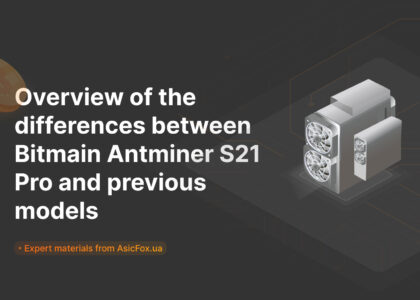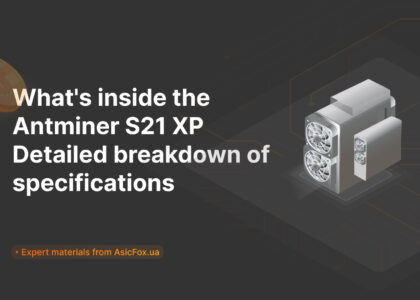The complexity of digital currency mining. How can the network hashrate affect profitability?
The difficulty of mining digital gold is a special parameter of the calculation algorithm called Proof-of-Work. It directly affects the search time for a completely new block, or in other words, a hash.
The chance that a block will be found decreases in proportion to the increase in network complexity. Accordingly, with a decrease, a new hash will be determined much earlier. The graph below shows that the complexity of mining the most popular digital currencies is constantly increasing.
Therefore, the fact that the complexity of the digital asset network is regularly increasing protects it from the so-called “Attack 51”. At this point, the user’s computing power allows him or her to confirm his or her own blocks. This changes the information in the blockchain and blocks every third-party transfer.
Complexity of digital currency mining: what is it?
Mining difficulty is a special parameter of the Blockchain network. It reflects how difficult it is to perform mathematical calculations to find new hashes. And, of course, to make a profit from it.
What is the purpose of network complexity?
Mining cryptocurrencies such as Bitcoin and many others is considered profitable as long as the price of the mined assets remains higher than the cost of equipment and electricity. This indicator is one of the most important in the process of digital currency mining. After all, it is the network complexity that shows how many mining devices and what power should be used.
In fact, the complexity allows users to select the most energy-efficient devices. They will be able to provide the highest profit. The complexity of mining also keeps the rate of new asset issuance under control.
How can mining complexity change?
In the Bitcoin network, changes in complexity occur every 2016 hashes. It depends on the time period required to find the previous 2016 blocks. By the way, Nakamoto originally intended that blocks should be found every ten minutes. This is necessary to support the planned issue of 21 million coins. Then, 2016 hashes will be found in about 15 days.
If they are found faster, the difficulty will decrease. If it takes longer, it will increase.
Cryptocurrency mining difficulty: what can affect it?
This indicator directly depends on the network hash rate. It is also affected by the time spent on finding previous hashes.
If the network’s hashrate has increased, it means that new miners have joined the digital currency mining. They have connected their own hardware. This is the reason why the network’s computing power has increased.
The main ways to change the difficulty
As you know, the correction is performed by 2 methods. For example:
– By changing the number of blocks. For example, bitcoin and litecoin update every 2016 blocks. The new value is set so that the time spent searching for a new block is fixed.
The recalculation is performed for all farms and pools separately, independently of each other. It is for this reason that all coin-mining nodes have different current values. By the way, the graph of the complexity of digital currency mining shows only the average range.
– It is also customary to take into account the total capacity of the mining network, expressed in hashrates. Its growth means that other users have joined the mining process. Therefore, it is necessary to increase the complexity. When the complexity decreases, the time to find a new hash increases, but the complexity itself decreases.
This approach is not as fair to small farms as the previous one. Because adding huge computing power increases the level for everyone.
However, it also happens that the definition of “mining difficulty” becomes meaningless, and there is simply no graph. How is this possible, you may ask? In fact, when all coins were obtained at the stage of cryptocurrency creation. For example, it can be Ripple.
Network hashrate: what is it?
Hashrate is the total computing power of the equipment intended for cryptocurrency mining. It can be expressed in the following dimensions:
– Hash/sec (H/s);
– KiloHash/s (KH/s);
– Megahash/s (MH/s);
– GigaHash/s (GH/s);
– Terahash/second (TH/s);
– Petahesh/s (PH/s);
– Exahesh/s (EH/s).
Since mining is regularly becoming more complicated, it is very difficult to observe such a unit as “hash per second”. Especially in modern Blockchain networks. Today, such tasks can be solved only with the help of special devices. They must have increased power.
For example, if the processor capacity is 10 mega-hashes per second, it means that in one second it can generate about 10 million different variants of numbers. They are needed to find the only hash that corresponds to each parameter set by the network.
What affects the hash rate?
This indicator depends on a whole list of basic parameters. This includes the chosen digital currency mining algorithm. For example, there are devices that can produce the highest possible performance in the middle of the network using the SHA-256 algorithm. It can be Peercoin, Bitcoin, Namecoin. However, their efficiency is much lower in a network running on the Scrypt algorithm. For example, Dogecoin, Litecoin, Gridcoin.
Device specifications are also important, as they differ from each other due to different manufacturers. Future miners should read information about the power of the device. This is the only way to choose the most profitable, efficient, and optimal mining equipment.
You should also keep in mind how popular a particular digital currency is. Naturally, the more in demand it is, the more users are interested in mining it. Miners connect their own computing power to the network. This increases its hash rate and, as a result, the complexity of mining digital gold.
How can I calculate the income from cryptocurrency mining?
To calculate this parameter, you can use a special mining profitability calculator. For example, if you know the hashrate of your own machine, you can calculate the possible income for the future for a certain period of time. In fact, given the dynamic development of the hashrate, these calculations cannot be considered absolutely correct and accurate. Therefore, you need to take information from 2-3 sources and then calculate the average value yourself.
How can you calculate the mining difficulty?
We need the following formula:
difficulty = difficulty_1_target / current_target where difficulty is the difficulty and target is a 256-bit number. Difficulty_1_target can take on different values. Usually, it is a hash, the first 32 bits of which are 0, and the rest is made up of numbers and letters (also called pdiff or pool difficulty).
This formula is not easy to understand the first time. For this reason, you should use some special resources to control the difficulty. They must necessarily present images in the form of graphs. For example:
– Bitcoinwisdom,
– Coinwarz (multiple choice),
– Blockchain.com, Bitcoincity,
– Etherscan (for ETH).
It is also worthwhile to assess the complexity of cryptocurrency mining after studying several sources. After all, the indicator can be quite dynamic, and the value itself will be changeable.
How can complexity affect the profitability of cryptocurrency mining?
Below is a graph that clearly shows that since 2017, the complexity of mining such a popular coin as Bitcoin has been rapidly increasing. However, its growth was stopped for a short time until November 2018. At that time, there was a rather sharp market crash. At the same time, the hash rate also declined.
A similar situation is repeated with more liquid digital currencies. Moreover, not so long ago, industry experts estimated the increase in the complexity of the most popular altcoins every month. This value was approximately 8 percent.
Since then, there have been minor changes. However, if you rely entirely on these numbers, then with an 8 percent increase in complexity in 30 days, in just 9 months, the return on computing power will be zero.
Therefore, when the value of the BTC coin dropped to $4,000, some miners began to buy more expensive mining devices. And some simply shifted their attention to mining digital assets due to the lower complexity.
Of course, you may immediately think that the first option is too expensive and the second is risky. The most ideal option is the “golden mean”. In other words, mining digital currencies with a medium level of difficulty.
Conclusion.
To summarize the above, it is also worth noting:
1. If you are looking for coins with a low difficulty, you need to take into account the size of the reward. Also, assess the prospects for its development. Even when a miner finds and signs new blocks quickly enough, you should not be overly optimistic. The undervalued exchange rate at the time of exchange for fiat money may simply not cover the cost of electricity. I’m not even talking about mining income.
2. Traders should regularly monitor the difficulty of mining “digital gold”. The fact is that this is a mandatory tool of a comprehensive trading strategy. Since the cryptocurrency market, due to its youth, has not been able to form its own set of technical and statistical predictive factors, it will be necessary to use any source of information.
It is worth remembering that users’ income is accrued in cryptocurrency coins. We have to make purchases in real money. For this reason, they are well aware of the situation on the cryptocurrency exchange. They themselves are considered the strongest fundamental factor.







Feedback (0)
Leave a review